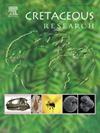巴西maranh Parnaíba盆地Itapecuru组“Boca de Forno”峡谷中的一颗齿龙
IF 1.7
3区 地球科学
Q1 GEOLOGY
引用次数: 0
摘要
Carcharodontosauridae是中等到非常大的异特龙类兽脚亚目的一个分支,长6-14 m,主要分布于早白垩世和中白垩世,其特征是深而窄的装饰头骨和强烈压缩的ziphodon牙齿。在巴西,carcharodontosaurus的化石记录仅限于脱落的牙齿和该国东部Aptian-Cenomanian沉积物中分离的颅后元素。在这里,我们描述并鉴定了来自巴西东北部maranh本文章由计算机程序翻译,如有差异,请以英文原文为准。
A carcharodontosaurid tooth from “Boca de Forno” Ravine of the Itapecuru Formation, Parnaíba Basin, Maranhão, Brazil
Carcharodontosauridae forms a clade of medium-to very large-sized (6–14 m long) allosauroid theropods mostly restricted to the Early and mid-Cretaceous with an almost global distribution, and characterized by deep and narrow ornamented skulls and strongly compressed ziphodont teeth. In Brazil, the carcharodontosaurid fossil record is limited to shed teeth and isolated postcranial elements from the Aptian-Cenomanian deposits of the eastern part of the country. Here we describe and identify a shed tooth from a little-known outcrop of the Early Cretaceous (Aptian-Albian) Itapecuru Formation of the Maranhão State, northeastern Brazil. Although some teeth have already been reported from the Aptian-Albian deposits of this unit, this specimen represents the first isolated dental material from the Parnaíba Basin that can be confidently assigned to a carcharodontosaurid through cladistic and morphometric techniques, but also based on a systematic study. The results of the herein conducted study suggest that the specimen belongs to a carcharodontosaurine closely related to the Patagonian taxa Giganotosaurus and Mapusaurus, which are younger in age. Although the specimen is closely related to the abovementioned Patagonian taxa, the faunal composition of the Parnaíba Basin seems to be more similar to that of North Africa. Nevertheless, further collecting efforts are needed in these localities to find skeletal carcharodontosaurid remains and to broaden the comparative base for the identification of theropod dentition.
求助全文
通过发布文献求助,成功后即可免费获取论文全文。
去求助
来源期刊

Cretaceous Research
地学-地质学
CiteScore
4.10
自引率
19.00%
发文量
235
审稿时长
12 weeks
期刊介绍:
Cretaceous Research provides a forum for the rapid publication of research on all aspects of the Cretaceous Period, including its boundaries with the Jurassic and Palaeogene. Authoritative papers reporting detailed investigations of Cretaceous stratigraphy and palaeontology, studies of regional geology, and reviews of recently published books are complemented by short communications of significant new findings.
Papers submitted to Cretaceous Research should place the research in a broad context, with emphasis placed towards our better understanding of the Cretaceous, that are therefore of interest to the diverse, international readership of the journal. Full length papers that focus solely on a local theme or area will not be accepted for publication; authors of short communications are encouraged to discuss how their findings are of relevance to the Cretaceous on a broad scale.
Research Areas include:
• Regional geology
• Stratigraphy and palaeontology
• Palaeobiology
• Palaeobiogeography
• Palaeoceanography
• Palaeoclimatology
• Evolutionary Palaeoecology
• Geochronology
• Global events.
 求助内容:
求助内容: 应助结果提醒方式:
应助结果提醒方式:


